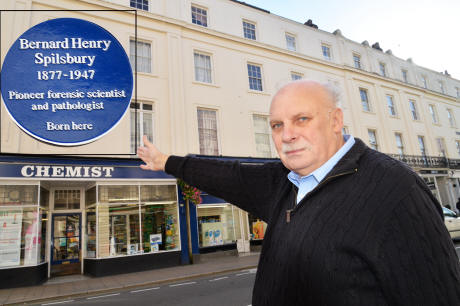BERNARD Spilsbury, known as the father of modern forensics, has been honoured with a blue plaque in his home town of Leamington.
The plaque, which can be seen on Birk & Nagra chemist on Bath Street where Spilsbury was born in 1877, is the latest in town recognising notable Leamingtonians.
Spilsbury was a pioneering pathologist, who shot to public attention during the infamous Dr Crippen case in 1910. He gave forensic evidence as to the likely identity of the human remains found in Crippen’s house. Spilsbury concluded a scar on a small piece of skin from the remains pointed to Mrs Crippen as the victim.
Spilsbury later gave evidence at the trial of Herbert Rowse Armstrong, the solicitor convicted of poisoning his wife with arsenic.
The case that consolidated Spilsbury’s reputation was the ‘Brides in the Bath’ murder trial in 1915. Three women had died mysteriously in their baths, and each appeared to be an accident. George Joseph Smith was brought to trial for the murder of one of these women, Bessie Mundy.
Spilsbury testified since Mundy’s thigh showed evidence of goose bumps and, since she was, in death, clutching a bar of soap, it was certain that she had died a violent death.
Spilsbury was educated at Leamington College before the family moved to London. He later attended Magdalen College in Oxford, and St Mary’s Hospital in London, where he specialized in the then-new science of forensic pathology.
During his career Sir Bernard Spilsbury performed thousands of autopsies, not only for murder victims but also of executed criminals, and he was knighted in 1923.
He was a Home Office approved pathologist, Lecturer in Forensic Medicine in the University College Hospital, London School of Medicine for Women and St. Thomas’ Hospital. He also was a Fellow of the Royal Society of Medicine.
He played a crucial role in the development of Operation Mincemeat, a deception operation during the Second World War, which saved thousands of lives of Allied service personnel.
Spilsbury had married Edith Horton in 1908. They had three sons, two of whom died during the Second World War, and a daughter.
Spilsbury’s last big case was the the De Antiquis murder – which saw Alec de Antiquis was shot dead in London’s West End in April 1947, while attempting to prevent the escape of three robbers from a jewellery shop.
Spilsbury continued to work until his death a few months later at the age of 70. He ended his life on December 17, 1947 by gassing himself in his laboratory. It is said that this was prompted by his ill health and depression following the deaths of his sons.
* A plaque was also unveiled at 43 Binswood Avenue to commemorate religious poet and hymn writer Frances Ridley Havergal,
It was sponsored by Churches Together in Leamington.











